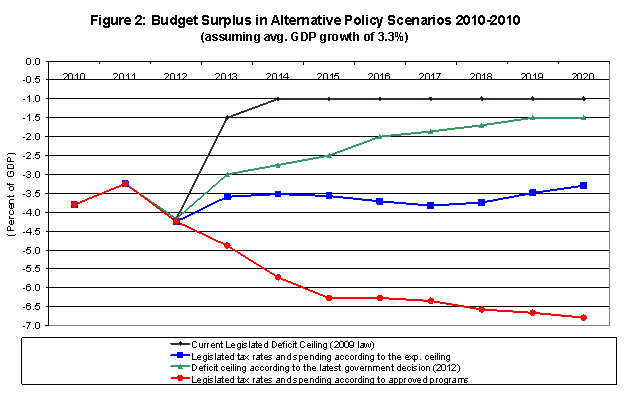![]() To view this press release as a Word file
To view this press release as a Word file
· The government budget deficit for 2012 was 4.2 percent of GDP, compared with a target of 2.0 percent of GDP set when the budget was approved at the end of 2010, and about 1 percentage point of GDP greater than the deficit in 2011.
· Most of the deviation from the targeted deficit reflects lower tax receipts than originally projected. This gap is mostly explained by different macroeconomic developments than forecast when the budget was approved.
· Bank of Israel projections, based on decisions and programs adopted by the government, forecast expenditures for 2013 to be 9 percent greater than in the 2012 budget, and NIS 13 billion above the expenditure ceiling according to the expenditure rule approved in 2010.
· Significant additional gaps exist between the expected cost of the programs approved by the government and the expenditure ceiling in 2014 and 2015.
· If the government aligns the increase in expenditure in 2013 with the expenditure ceiling, and does not change the tax rates set in law, the deficit, based on forecast growth of 3.8 percent, is expected to be 3.6 percent of GDP, greater than the new deficit target of 3 percent of GDP adopted by the government in the summer of 2012. That is, to meet the deficit target, it will also be necessary to increase tax rates or to cancel exemptions. If the government does not adjust its expenditures, the expected deficit in 2013, based on the costs of the programs approved by the government and the tax rates set in law, is 4.9 percent of GDP.
· Without significant adjustment of the government budget—both a reduction in government commitments to increased expenditures, and higher tax receipts—the debt to GDP ratio is not expected to decline in the coming years, unless the growth rate is especially high – more than 5 percent per year, on average.
The budget deficit in 2012 was 4.2 percent of GDP, about 2 percentage points of GDP above the deficit ceiling set when the budget was approved at the end of 2010, and about 1 percent of GDP greater than the deficit in 2011. Most of the deviation from the deficit ceiling reflects tax receipts which were about NIS 14 billion below projections when the budget was approved. The balance reflects lower than projected non-tax revenues, for the second consecutive year, and expenditures in excess of the original budget, made possible by the transfer of unutilized balances from previous years' budget.
An examination using the Bank of Israel Research Department's tax model indicates that most of the gap between actual tax receipts and the budget forecast derives from lower than expected growth of two macroeconomic variables—wages and new home sales. According to the model, about a quarter of the deviation can be attributed to an overly optimistic forecast based on the available data when the budget was approved two years ago. Most of the gap was already identified during 2011, and, at the end of 2011, the government accordingly increased the forecast deficit to 3.4 percent of GDP. However, as it operated within the framework of a 2-year budget, no adjustments were made at that time in order to reduce the deficit. It was only in the second half of 2012, as the deficit continued to grow, that the government decided to increase tax rates in order to reduce the deficit, primarily heading into 2013.
In addition to below-forecast revenues, the government's expenditures in 2012 were greater than originally budgeted. If the government does not make adjustments to reduce the increase in expenditure, so that it is aligned with the expenditure ceiling set by law, a consistently increasing gap between government expenditure and the ceiling is expected over the coming years, as several of the government's programs are multiyear initiatives. In 2013, the gap between total expenditures, including the costs of the programs approved by the government, and the expenditure ceiling, is expected to be about NIS 13 billion, and in 2014 and 2015 the gap is expected to be markedly greater. Aligning the increase in government expenditure with the ceiling set in law will thus pose a significant challenge to the government when constructing the budgets for 2013 and future years.
An examination of the expected path of the deficit and the debt to GDP ratio in coming years indicates that if the government reduces the increase in its expenditure to the ceiling set according to the expenditure rule, and maintains the tax rates set by law (including already approved changes for upcoming years), the expected deficit will be higher than the increased deficit targets which the government adopted in 2012, and the debt to GDP ratio will not decline until the end of the decade. To meet the deficit target for 2013, NIS 6 billion in increased tax receipts are necessary, which means, taking into account the effect of taxes on activity, tax rates will have to be increased, or tax exemptions reduced, by the equivalent of NIS 7.5 billion. After 2013, additional tax measures will be necessary. If the government increases its expenditures in accordance with the cost of the programs it has approved, the deficit in 2013 will reach nearly 5 percent of GDP, and will continue to increase in upcoming years as well. As a result, the debt to GDP ratio will approach 100 percent toward the end of the decade, even using lenient assumptions regarding the impact of the deficit and debt on interest rates and growth.


